Tour the Foodie Havens of Saint-Germain
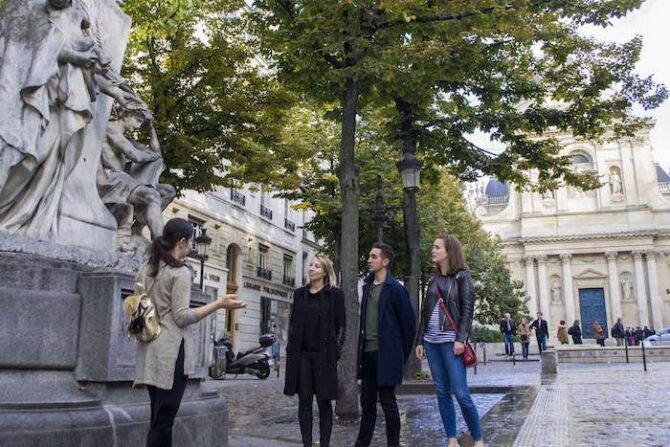

The highlight of my last trip to Paris? Two and a half hours wandering Saint-Germain with a knowledgeable guide who knew all the best places to buy foodie treats and could chat, philosophize even, about the historical and cultural aspects of French food.
I met Isobel from Context Travel on the corner of Rue Jacob and Rue des Saints-Pères, where she explained that the plan was to tour some of her favorite shops, do a little shopping and then stop off in an artisanal bakery where we could picnic on our purchases in style. But first, she said, let’s call into one of Alain Ducasse’s chocolate shops and get you a little something to welcome you to our tour. The three of us – a couple from Illinois were there too – exchanged smiles of pleasure. We were going to be roundly indulged. How lovely!
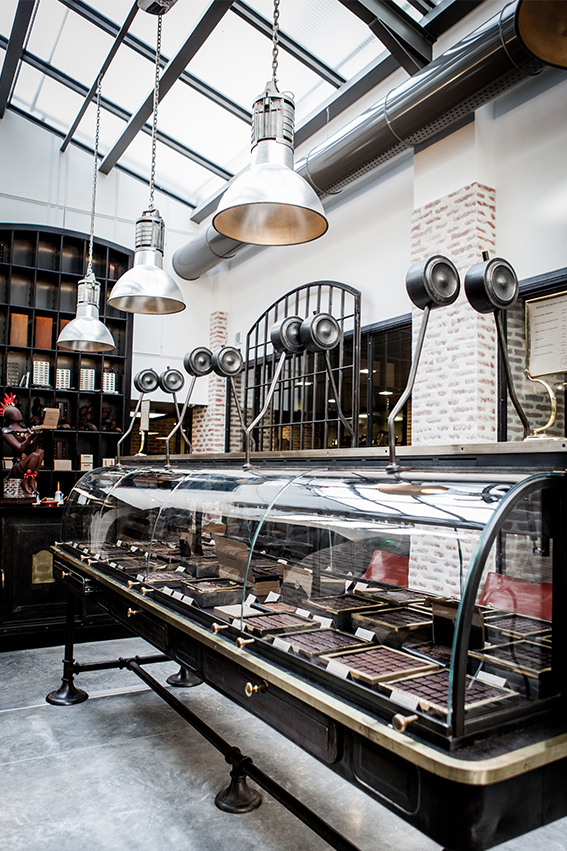
La Manufacture de Chocolat/ Alain Ducasse
Did we know, asked Isobel, that Alain Ducasse has been awarded over 20 Michelin stars during his career? Or that, never finding just the right chocolate for his recipes, he decided to open his own factory and oversee every aspect of the process from bean to bar. We were offered two samples, a chocolate and a spoonful of chocolate paste, and a crisis of indecision followed as we contemplated the vast array of options. Which single origin chocolate to choose? Peruvian maybe, or perhaps one from Madagascar? Flavored with almond or coconut? What about sesame or fleur de sel? Isobel was on hand to advise and on the way out I noticed a solution for next time: buy a coffret découvert, that is a selection box of 20 different chocolates.
We then wound our way through Rue de l’Université and Rue du Bac to one of Isobel’s favourite delis, passing a Relais de l’Entrecôte on the way. That, said our guide, is a good option for a tasty, not-too expensive meal. They only do steak-frites, but they do it well. As we approached the Maison Guyard, she had another tip. “If you see the word traîteur on the shop sign, then you know it’s a proper delicatessen, one where some of the produce is made on the premises.” We bought rosette – a pile of papery thin rounds of sliced salami – and mousse de canard with its thick topping of yellow duck fat, and rillettes, that is shredded meat cooked in fat with, said Isobel, the texture of pulled pork.
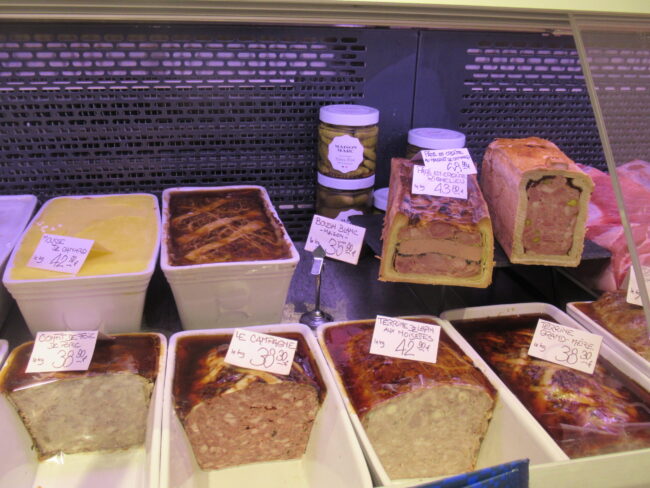
Stopping by a Paris deli on a Context Food Tour. Photo: Marian Jones
Outside the maître fromager we visited next, Isobel asked if we knew how many different cheeses are produced in France and we all vastly underestimated the answer. I added a couple of hundred to the 246 I knew President de Gaulle had cited and thought I’d be close. Ah, non. More like 1400! How on earth to choose? Well, I learned, spotting a red and yellow circular label marked AOP is a good start. That stands for Appellation d’origine protégée, meaning you know the ingredients came from a particular region and the product was produced there. An authentic local product in other words.
We were quizzed on our knowledge of washed rind versus bloomy rind and introduced to cheeses from cow, sheep, goat and buffalo milks. We discovered that this fromagerie stocks more than 30 types of goat’s cheese and began to wonder how we were ever going to choose. Isobel had two tips. First, we’d ask them to make us up a platter of five different cheeses, just as a French customer might do when planning un dîner. Secondly, we should consider asking to have some portions vacuum packed so that they would make the journey home and could be enjoyed there. The samples offered also helped and were even tastier when an assistant emerged from the kitchen with tray of freshly baked little biscuits to go with them.
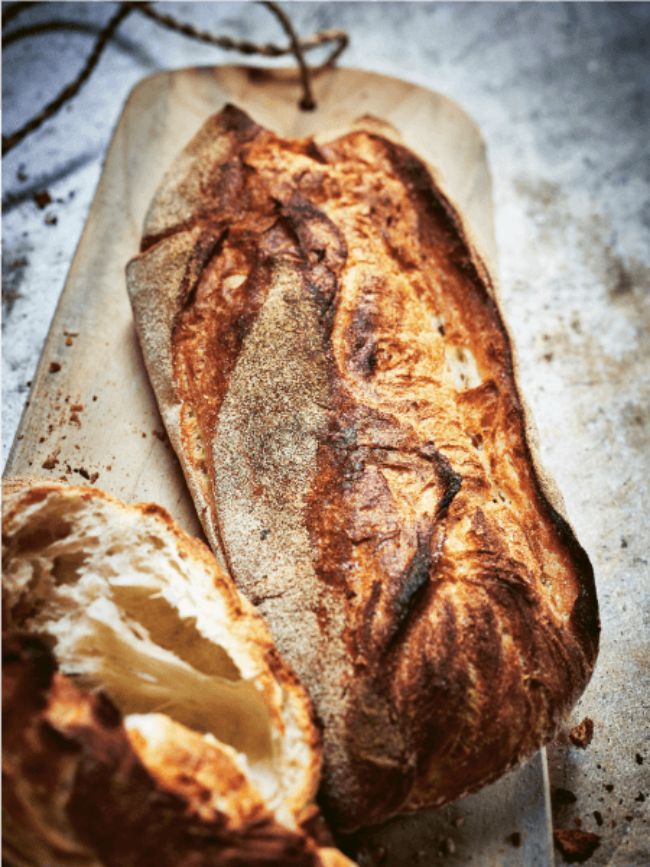
Image: “The Bread Book” by Éric Kayser
Next, off to Eric Kayser’s boulangerie artisanale, where they bake everything themselves. Here, a table was set aside for us and the picnic began. “I’ve bought us a baguette de tradition to share,” said Isobel. “So that means the only ingredients are flour, salt, yeast or sourdough and water. Nothing else. It’s made by hand and has most definitely not been frozen. Ever.” Won’t that mean it doesn’t keep well? Well yes, but it’s fine to buy half a baguette. No one will mind because everyone knows it will only last half a day. I felt we were learning how to become more French. No more baguettes ordinaires for me!
Our cheese platter, explained Isobel, was a classic of the genre, a good mix of hard and soft cheeses from various milks and including a blue cheese. She talked us through our selection: Comté made with unpasteurized cow’s milk from the Franche-Comté region, Ossau-Iraty, a Basque cheese made with sheep’s milk, Rocamadour, a creamy goat’s cheese, then Brie de Meaux, France’s best brie made just 50 kilometers from Paris and a mild blue Fourmé d’Ambert from the Auvergne. Also on the platter was a little portion of pear fruit jelly, an aromatic accompaniment to contrast with the cheeses.
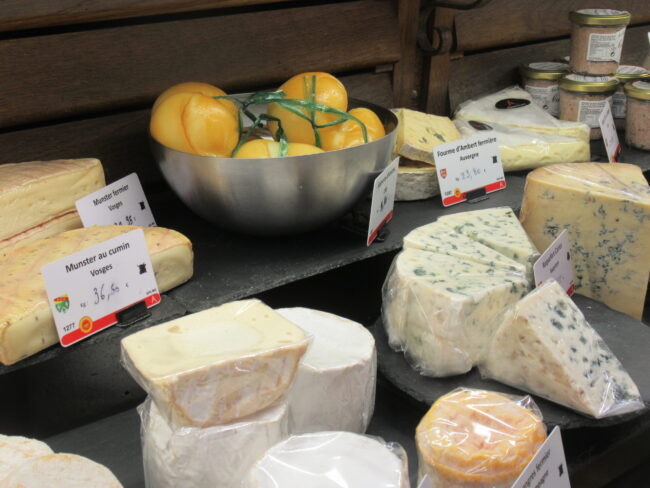
Learning about cheese on a Context Food Tour. Photo: Marian Jones
I wondered if it was true, as I had read, that it was easy to offend one’s host by cutting cheese wrongly. Gosh, yes. You should always cut across the whole cheese, thus avoiding leaving a piece which is mainly rind for someone else. So, you’d cut off a strip of Comté but a triangle of Camembert. The conversation widened out into French habits more generally. What time do the French serve le dîner? Never before 8 pm – any earlier and you must be a foreigner! Do they really prepare several courses of fresh food every evening? Ah, no, it’s quite common to source a starter at the delicatessen, or a dessert tart at the pâtisserie.
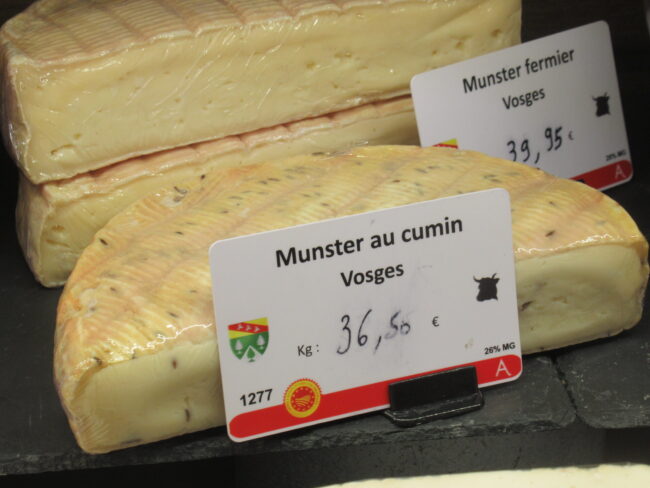
Cheese sampling on a Context Food Tour in Paris. Photo: Marian Jones
We moved on from the topic of food. Isobel, after five years in Paris, was a good source of information for all the things we’d been wondering. Why is it that French drivers seem unwilling to stop at a zebra crossing? Ah, said Isobel, they will if you are confident. You just have to face them down. If the crossing light is on, look the driver in the eye and set off across the road as if you really mean it. What should we look out for in Saint-Germain? Drop by Deyrolle (Rue du Bac), a taxidermy shop with the most amazing collection of stuffed animals. Convivial though the chatty atmosphere was, we moved on. It was time for dessert.

Saint-Germain-des-Prés. Photo credit: Mbzt / Wikimedia commons
Mousse au chocolat? Or pâtisserie? The choice was ours and soon we were at a second chocolaterie, revising what we had learned at Alain Ducasse. Which beans? What percentage? After consultation with Isobel I went for Ecuador, 75% and was soon spooning the chocolate nectar out of a paper cone like a child at the beach. Délicieux! Clearly a digestif was then called for, so off we set to the nearby specialist wine shop Ryst Dupeyron, where the crowded wooden shelves, dating from 1905, were stacked full of bottles. Isobel served us each some oak-aged Armagnac and then – why not? – a little chaser of Porto. It was an excellent way to round things off.
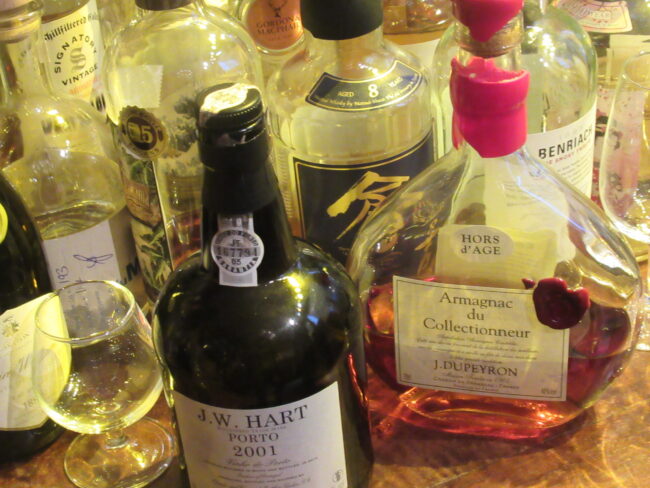
Maison Ryst Dupeyron. Photo: Marian Jones
Clearly a foodie, Isobel was the perfect guide, delighted to share her extensive knowledge, and very accommodating. I looked up the reviews left by previous guests and immediately recognized the willingness to help which they described. One guest recalled her finding a gluten-free baguette when required, another had been delighted to receive a follow-up email with restaurant recommendations. A Context Travel tour is known for the quality of its guides, knowledgeable in their fields: historians, archaeologists, art historians, food experts. And all of them, as the website puts it, are “people who call Paris home.”
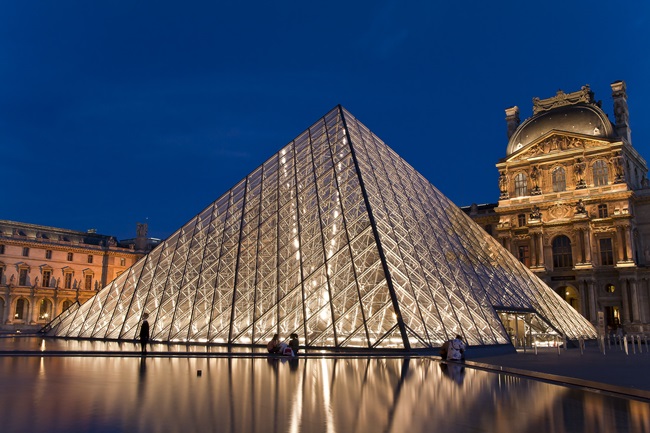
The Louvre Museum. Photo: Seryani/Flickr
There is a wide range on offer, both small group tours and private tours. Walking tours in Paris include history themes such as the Nazi Occupation and Resistance, or the French Revolution, where you’ll combine hearing stories from the past with visiting the places where they happened. There are area tours, such as Montmartre and Jewish Paris, and themed tours, for example a three-hour “guided crash course in the Louvre.” You’ll see a mix of famous and not-so-well-known works, with a chance to explore your own preferences too. There are also self-guided audio tours on offer and accompanied day or half-day trips to, say, Normandy or Monet’s Giverny.
Whatever your interest – any of the above, fashion history, something to interest your children and many more – you’ll probably find it on the Context Travel website. And if you have as enjoyable and informative a tour as we did, then I think you’ll be happy with your choice.
Context Travel Tours in Paris
Prices vary according to the tour taken and the exchange rate at the time of booking.
The Essentials of French Cuisine Tour described here lasted 2.5 hours and cost $200 per person, including a selection of gourmet tastings.
Lead photo credit : courtesy of Context Travel
More in baguette, cheese, chocolate, Context Travel, food tours, Paris food tours, Saint Germain


